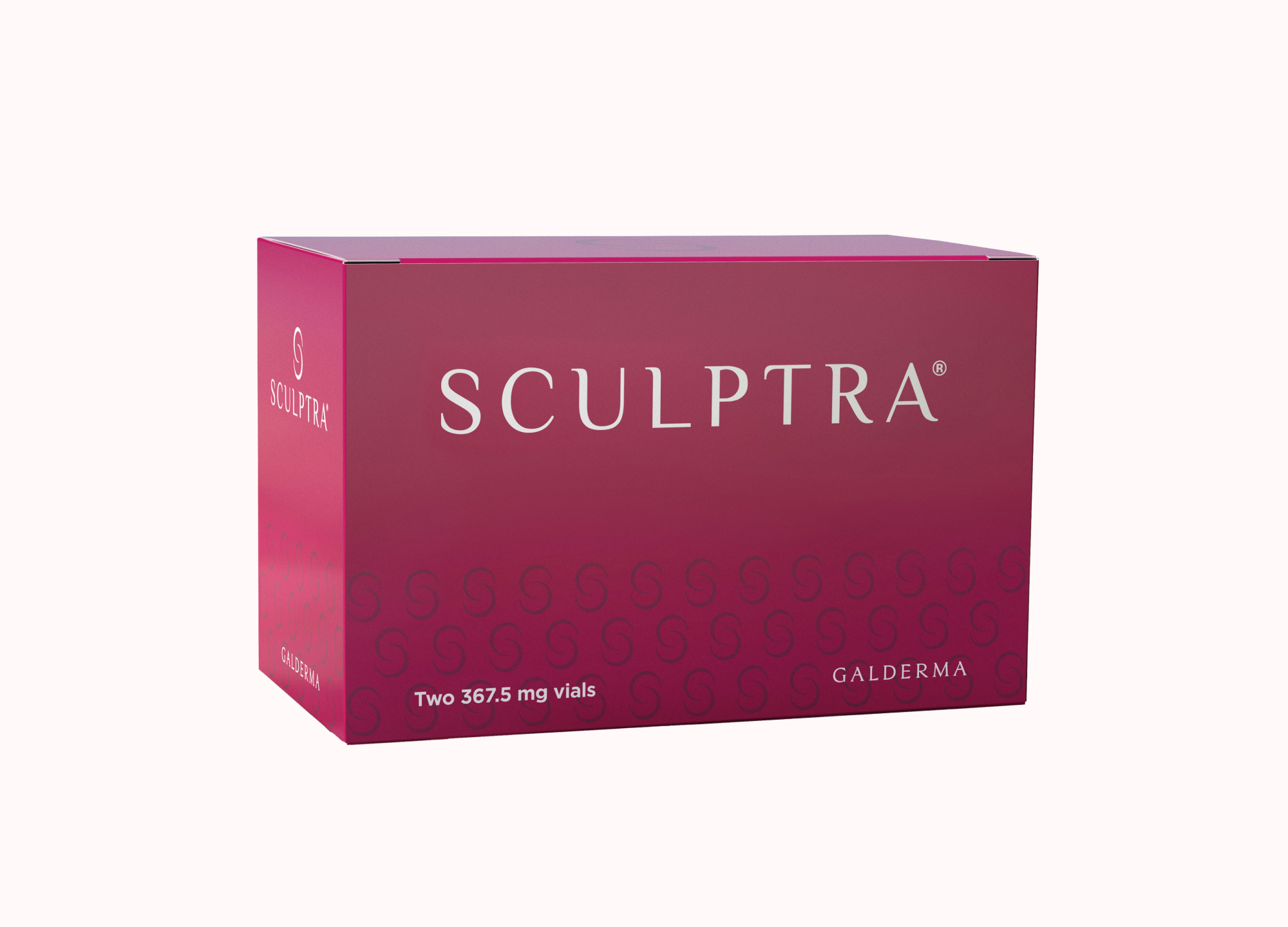This story has been medically reviewed for accuracy by Plano, TX board-certified facial plastic surgeon Dr. Vu Ho on September 30, 2020.
With so many wrinkle treatments on the market, it’s hard to decide which one might be the best option for you. Each treatment is designed to give you a refreshed, younger look—some are very similar, while others work in specific areas. Among these various wrinkle treatments, Sculptra is unique in that it is made of poly-L-lactic acid (versus hyaluronic acid) and works with your body to gradually regrow collagen over time, typically 2-6 months. Because your body’s newly synthesized collagen acts as the filler, these results can last up to 2 years or more.
In order to help you figure out whether Sculptra is right for you, we tapped into the expertise of RealSelf doctors and relied on the experience of RealSelf members to identify key factors that make Sculptra different from the rest.
1. What is Sculptra for?
Sculptra filler is an FDA-approved injectable that is designed to fill wrinkles and reduce hollow, sunken cheeks. “Sculptra is a biostimulatory filler, which means that it stimulates the patient’s body to make its own collagen,” explains Dr. Papri Sarkar, a board-certified dermatologist in Boston. “Because your body is tasked with making the protein instead of just receiving it, like with hyaluronic acid fillers, it takes longer to see results, but the effects last much longer.”
Dr. Sarkar loves offering Sculptra filler for her patients who have deep lines or volume wasting in areas like the temples and the lateral cheeks. “Because your body does part of the work, I find that it is less expensive overall for patients who need a lot of volume than classic hyaluronic acid [HA] fillers,” she says. “Even more important, perhaps, done right, [Sculptra] looks incredibly natural—your own mom wouldn’t be able to tell that you had Sculptra injected, since it’s a slow and steady building of support for your skin.” This slower process means that qualified candidates must be patient because the results are not immediate. For the same reason, many patients prefer the slow, gradual results from Sculptra because the change appears more natural as the volumizing effect occurs over a longer period of time.
2. How do I choose a Sculptra provider?
As with any cosmetic procedure, experience and skill matter when picking a Sculptra provider: a more experienced provider may produce better results. One key to picking a provider for your Sculptra face injections is actually knowing who will do the injections. You may go to the office of an experienced board-certified doctor, but that won’t matter much if an inexperienced nurse does the Sculptra filler.
“You should always question the potential provider about how long they have been injecting Sculptra,” says Dr. Marguerite Germain, a board-certified dermatologist in Mount Pleasant, South Carolina. “In order to get the best results, I would avoid any provider who does not have a high level of experience with the product.”
Dr. Sarkar seconds this statement, cautioning anyone interested in Sculptra to do their research beforehand. “One way to tell who uses it often is asking if they use it on the face and/or body,” says Dr. Sarkar. “Usually, doctors who feel comfortable using it off the face have more years of experience with the product.” Popular body treatment areas include buttocks, back of hands, and decolletage.
Find a provider with a proven history of good results.
3. What to expect in the Sculptra consultation
Not only is finding an experienced and skilled provider important, but it’s also vital that you’re comfortable and trust the doctor. A good way to find the perfect fit is to go to multiple consultations until you find a provider you like. A good way to find the perfect fit is to go to multiple consultations until you find a provider you like, and who can share a variety of great before and after images of their work.
“I usually discuss the pros and cons of Sculptra versus another treatment modality—such as HA filler, laser, etc.—and then review the potential side effects, longevity, and [other factors] of all the options,” explains Dr. Sarkar. “We usually make a treatment plan so the patient knows exactly where I’ll be injecting and whether they will need one to three sessions.”
During a consultation, Dr. Sarkar also speaks with her patients about things that will make the treatment more successful, like avoiding any alcohol starting at least the day before your Sculptra treatment and avoiding NSAIDS, like ibuprofen, to avoid bruising. Additionally, she goes over things she’d like her patients to avoid post-appointment, e.g.: no exercising for 24 hours.
4. What is it like to get a Sculptra treatment?
Getting a Sculptra treatment is relatively simple and not unlike any other injectable treatment. Sculptra filler “is an injectable, so there is the possibility of mild discomfort, but your provider will apply a topical numbing agent to the area beforehand, to make the treatment as comfortable as possible,” says Dr. Germain. After the numbing cream, the doctor will mark areas they wish to inject with Sculptra filler. After the injections are completed, the doctor will massage the patient’s face for about five minutes, to distribute the product evenly.
5. Pain, swelling, and bruising are possible.
Many providers use a local anesthetic prior to the injections, to help limit or eliminate pain and discomfort, and the Sculptra side effects are usually mild. You’re likely to experience some bruising from the injection, but it should fade quickly.
“The potential Sculptra side effects are very similar to [those of] HA filler injections, but they tend to happen rarely,” says Dr. Sarkar. “Swelling, bruising, and redness are most common.”
6. How to reduce recovery time
There shouldn’t be much recovery time from Sculptra face injections—if you experience swelling or bruising, there are things you can do to assist in the recovery process. “Avoiding blood thinners prior to your appointment and abstaining from exercise for 24 to 48 hours after treatment can help reduce the recovery time, as will a proper post-treatment massage of the treated area by your injector,” says Dr. Germain.
7. Is there required downtime after Sculptra?
You’ll be able to continue with your regular day-to-day activities right after the procedure. You might want to adjust your schedule, to allow some time for the swelling and bruising to go down. “There is also the possibility of slight social downtime, due to mild swelling, bruising, and soreness,” explains Dr. Germain.
8. What are the side effects and risks of Sculptra?
Along with potential bruising and swelling, you might experience the formation of noticeable lumps at the injection sites. “Sometimes after the injections, patients may develop nodules, but with proper dilution, the incidence of this has decreased significantly,” explains Dr. Sarkar. Frequent massaging of the treated areas afterwards as specified by your provider also helps to reduce the formation of nodules.
9. How to avoid Sculptra lumps
The process for avoiding lumps starts before you receive treatment—meaning, you need to find a skilled and experienced provider to administer your Sculptra treatment and avoid lumps.
“To avoid getting lumps, it’s important to choose an experienced provider who is aware of the best techniques—they should understand where to place the product—it’s best to avoid the eye and mouth area when injecting with Sculptra filler—and how to massage the treated area post-injection,” explains Dr. Germain. “While there is no way to dissolve lumps, they do dissipate with time, and with the proper injector and correct massage technique, the probability of their developing in the first place massively decreases.”
Related: RealSelf doctors weigh in on how to avoid lumps after Sculptra
10. How to dissolve Sculptra lumps
If lumps develop shortly after your procedure, frequent massages may help disperse the product. Many providers recommend the 5-5-5 massage rule—massage the area at least five times a day, for five minutes each time, for the first five days after treatment. If massaging doesn’t work, some providers will inject a steroid, such as Kenalog, directly into the nodules to help break them down. Lastly, having the lumps surgically removed is an option.
If you don’t want to get them surgically removed, you can always just wait it out until the Sculptra filler dissolves—Sculptra is a long-lasting treatment, but it isn’t permanent. Eventually, the treatment will run its course and any impact should resolve itself.
11. When will I see results?
The impact of Sculptra is a gradual process, and the results should continue to improve over time as the Sculptra treatment helps your body produce natural collagen.
“When I inject Sculptra filler, patients initially look great, and when they leave the office, the effects slowly dissipate because the liquid solution containing the Sculptra particles is being absorbed by the body,” says Dr. Sarkar. “I usually tell patients to expect themselves to look just like they did before any treatment was done about 24–48 hours later. Then the skin does the hard work of using the polylactic acid to make collagen and build up to those results again.” Dr. Sarkar usually tells her patients that it will take four to eight weeks to see the results of their treatment, based on their age, but patients often note that they see a difference sooner.
12. Is Sculptra worth getting?
Considering RealSelf members give Sculptra a Worth It Rating of 79%, based on more than 100 recent reviews, we think it’s safe to say that in the hands of an experienced provider, a Sculptra treatment is worth getting and tends to produce results.
Although the treatment seems to be worth getting, it’s definitely a commitment—for the best results, you might need to undergo multiple treatments and will also need to keep up with follow-up treatments. You may love the results, but even in a best-case scenario, they will probably only last for two to three years. At that point, additional treatments will be required, to maintain your look. Because of this, a facelift might be a better option for some; but for others willing to continue follow-up treatments, Sculptra is ideal.
Whether it is the right choice for you depends on your desires and expectations. Going over your goals and the benefits of Sculptra treatment with your provider before you receive any treatment is a great way to align your expectations and end up with a result that you feel good about.











